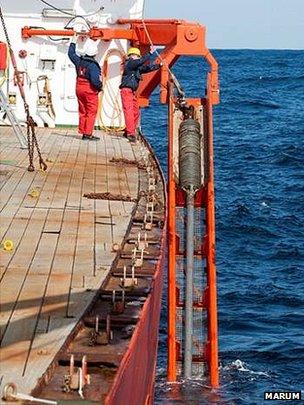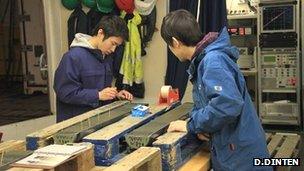Japan sea sediments tell of past 'Tohoku quakes'
- Published

The sediment cores were retrieved by a pipe that was pushed into the seafloor by a large weight
Previous earthquakes that rivalled the March 2011 Tohoku tremor in size may be recorded in sediment samples just recovered from the seafloor off Japan.
A <link> <caption>German-led scientific cruise</caption> <url href="http://www.marum.de/Background_information.html" platform="highweb"/> </link> obtained the cores from 16 different locations, some of them at a water depth of 7.5km.
The sediments hint at three major disturbances on the ocean bed that could be the result of the submarine landslides often seen with big quakes.
The researchers are currently trying to identify and date the events.
"For the purpose of seismic hazard assessment, we would like to know the recurrence interval - how often these very big earthquakes occur," said <link> <caption>Dr Michael Strasser</caption> <url href="http://www.geology.ethz.ch/people/Professors/michastr" platform="highweb"/> </link> , from the Swiss Federal Institute Of Technology Zurich, Switzerland.
"At the moment, we simply don't have that information," he told BBC News.
Dr Strasser has been talking here at the European Geosciences Union (EGU) meeting in Vienna, Austria.
Dr Michael Strasser: Volcanic ash in the sediments will tell us the timing of the events
He was describing the initial results to come out of the March/April cruise on the Sonne research vessel.
The expedition carried out a number of investigations but a significant part of the venture was dedicated to retrieving samples of the sediment on the seafloor.
The shaking and the upheaval of rock associated with the devastating 2011 tremor kicked up silts and muds, and in places triggered large volumes of material to slide down slopes.
All this can be seen in the 95m of sediment cores pulled up on to the ship.
But the samples do not just record the most recent quake; they also contain information about ancient events.
"We were able to get a record of at least three sedimentary mobilisation events that potentially suggest the occurrence of previous large, possibly 2011-Tohoku-type, earthquakes; and we are now working on identifying these events and then eventually dating them," said Dr Strasser.

Patterns in the sediment record past submarine landslide events
Tohoku had a Magnitude of 9.0. It was unprecedented in the instrumented era, although historical texts have indicated that there may have been something on a similar scale 500-1,000 years ago.
There is some geological data, also, pointing to perhaps another huge tremor 1,300 years ago.
But Dr Strasser and colleagues are just not able to say at the moment if these two distant events relate to the chaotic jumble of grit, pebbles and mud in their cores that is so characteristic of quake-mobilised sediment.
This will require some careful dating. Fortunately, the sediments also contain volcanic ash deposits which are relatively easy to put an age against.
Knowing something more about the size of submarine landslides in the region will also be important for gauging likely future tsunami hazards.
That is because the mass movement of sediment can also displace the water column, potentially amplifying the effects that come from the sudden displacement of rock in an earthquake.

The cruise will reveal information that will aid seismic hazard assessments
"Based on what we've seen so far, the submarine landslide associated with the Tohoku quake was a relatively small event, so it may not necessarily have added much to the large tsunami. But certainly in terms of future hazard, these landslides should be considered as possible tsunami generators," Dr Strasser warned.
The Research Vessel Sonne travelled along the east coast of Japan from 8 March to 6 April this year, to map and sample the seafloor.
The ship carried German, Swiss and Japanese scientists. The project was led by Prof Gerold Wefer, the director of Marum, the German Center for Marine Environmental Changes, at Bremen University.
Jonathan.Amos-INTERNET@bbc.co.uk and follow me on <link> <caption>Twitter</caption> <url href="https://twitter.com/#!/BBCAmos" platform="highweb"/> </link>
- Published23 March 2012
- Published22 February 2012
- Published22 February 2012
- Published9 August 2011